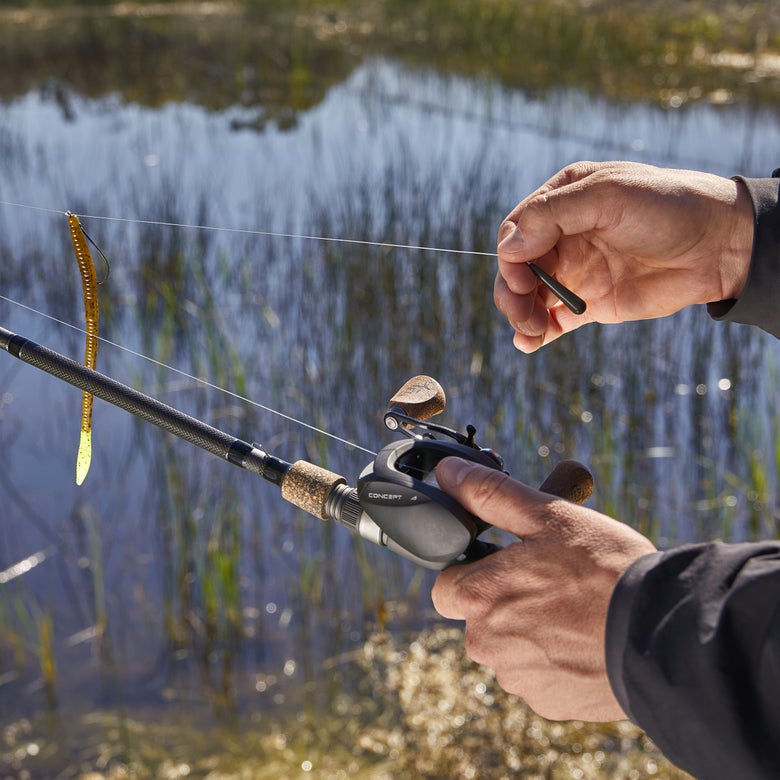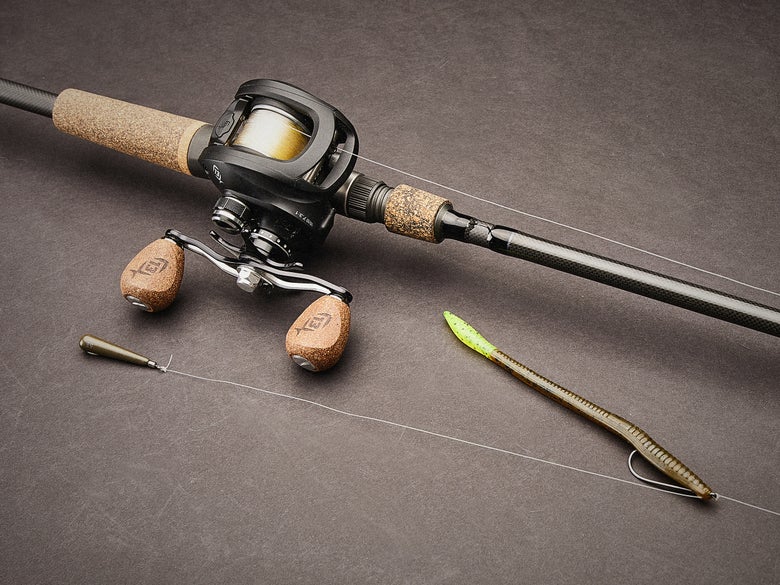Power Shot Gear Guide

No matter the season, a drop shot is easily one of the most effective techniques for catching bass. However, when fishing around vegetation or during the spring months, using light line can be an issue if you are targeting big spawning fish around matted cover and snag-ridden areas. The power shot is an up-sized, more heavy-duty version of the drop shot, making it the perfect choice for targeting bedding bass and fishing around heavy cover.
Instead of using a spinning setup with light line, the power shot employs baitcasting equipment, heavier line, and beefed-up tackle. In this article, we will go over the best gear for the power shot, explore modifications and rigging methods, and provide some seasonal tips and tricks that will get you ready to power shot with confidence!
Power Shot Rods
When choosing your power shot rod, a flipping stick seems like a logical choice, as you are often making short-range flips and pitches to close-range targets. The problem is the tip section on a flipping rod won’t load up properly due to the lighter tackle used on a power shot, and your accuracy will suffer. For that reason, a rod similar to your jig rod is the ideal choice. Look for a rod in the 7’ to 7’6” range with a medium-heavy to heavy power rating and a fast or extra-fast tip. These attributes will help you make accurate pitches to likely bedding areas or small targets around heavy cover, while also providing the power and bend you need to set the hook and horse big angry fish out of cover and back to the boat.
Power Shot Reels
A casting reel with a higher gear ratio is a top priority when you’re fishing around heavy cover or targeting bedding bass. Something with a 7:1 gear ratio or higher is a must-have to pick up line quickly for quality hook sets and horsing fish out of the thick stuff. A faster gear ratio also helps you get your bait in and out quickly, so you can make casts to multiple targets more efficiently. A 70- to 100-size casting reel will keep your setup lightweight and compact for increased comfort, and since casting distance isn’t as crucial, a reel with generous line capacity isn’t required. Many anglers are turning to 70-size reels or specialized flip-and-pitch reels for close-quarters fishing, as the shallower spool helps reduce backlashes and aids in fishing lighter lures.
Power Shot Line
Just like a traditional drop shot, always let the water clarity, cover, and weight of your rig dictate what size line you select for your power shot set up. Fluorocarbon lines between 12 and 25 lb are the best choice. If you are new to fishing the power shot, 16-lb fluorocarbon provides a good starting point, but you could definitely go down in line size if the water is super clear or go up in size when fishing dirty water or heavier cover. For extreme situations where you’re fishing over logs, behind flooded brush or around thick vegetation, you may want to consider switching to straight braid in the 50- to 65-lb test range. Many anglers prefer a braided mainline to a short fluorocarbon leader to help manage the line twist commonly associated with fishing a power shot all day.
Modifications and Rigging
To accommodate for the heavier line and casting gear used with a power shot, you will want to upsize the gauge of your hook to at least medium wire to avoid bending it out during a hookset. Choose a hook that allows you to Texas-rig your lure and conceal the hook point. A straight shank worm hook or extra-wide gap hook will keep the presentation weedless. Tie-on style drop shot weights are a better option for a power shot, as pinch style weights have a higher tendency to snag and fall off in heavy cover. Most anglers will use 3/8-oz to 1/2-oz weights, but you should adjust your selection depending on the cover and conditions. Some anglers will also add a swivel to their mainline to help combat issues with line twist that commonly plague the power shot. Check out our How-To rig Dropshot video for a closer look at the rigging.

Seasonal Tips & Tricks
During the spring, some fish may already be spawning, and they might not bite on the initial drop or first shake, so try soaking your bait a little longer before making your next cast. Bedding fish often short strike during the spawn, so downsizing your bait may be the difference between missing tail biters and coming in with a tournament-winning bag. The power shot is also great for experimenting with different soft plastic styles, so don’t be afraid to change it up and try something different, like small creature baits, craws, and lizards. Experiment with different leader lengths based on the situation; shorten your leader to get your bait closer to a bed during the spawn, or lengthen your leader to keep your lure above submerged vegetation in the summer.
Colors
When approaching a new body of water, natural colors like browns, greens, or baitfish imitations are always excellent patterns to start off with. Water clarity and local forage will play a big role in determining the best color, but it’s hard to beat green pumpkin, morning dawn, and oxblood patterns. If you are using the power shot to sight fish for bedding bass, try using bright colors like white, bubble gum, merthiolate, and chartreuse to help you detect bites in stained water conditions and let you know when the fish has taken your lure. Panfish typically move up to spawn after the bass do, so try using a worm with some chartreuse on the tail or belly to help imitate a bluegill.
Whether you’re fishing submerged vegetation offshore or flipping cover in shallow water, the power shot provides a weedless approach to presenting a drop shot with the added strength and leverage necessary for fighting fish back to the boat. Don’t forget to check out our drop shot gear guide(link) for more information on the time-tested finesse version of the power shot!























































































